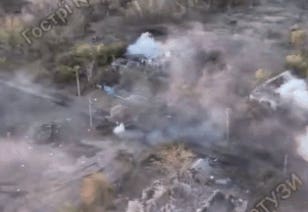The proliferation of tiny explosive drones all along the 800-mile front line of Russia’s wider war on Ukraine ushered in what one think tank called “the era of the cautious tank.”
But in Kurakhove, a front-line town in eastern Ukraine’s Donetsk Oblast, Ukrainian tanks are anything but cautious. Rolling out to meet a relentless Russian offensive, tanks from at least two Ukrainian brigades are battling Russian assault groups at point-blank range—and popping smoke to escape the inevitable drone attacks.
On or just before Monday, a pair of tanks—possibly from the 46th Air Mobile Brigade—engaged Russian troops at close range in the ruins of a shell-blasted neighborhood. The tanks fired and moved, fired and moved—and then sped away under the cover of their smoke generators, narrowly dodging at least one Russian drone that swooped overhead.
The shoot-move-smoke tactic is an effective one. “There are a few Ukrainian battalions I see use smoke very effectively, and they take noticeably fewer vehicle losses,” noted Andrew Perpetua, an open-source intelligence analyst.
Ukrainian tank battalions equipped with ex-German Leopard 1A5s and Leopard 2A4s as well as ex-Soviet models—T-64s and T-80s, it seems—have been fighting around Kurakhove for weeks.
In late October, the Ukrainians abandoned one damaged Leopard 1A5 while retreating west toward the most defensible part of Kurakhove, which lies on the west bank of a tributary of the Vovcha River. A Ukrainian artillery brigade blew the bridge over the creek a few days ago in order to complicate Russian advances.
The Russians are still coming. They can ford the creek, erect a temporary bridge over it or just bypass it by rolling through the village of Dalnje, a few miles to the south. Ukrainian tanks are confronting them at every approach.
At least one Leopard 2 from the 33rd Mechanized Brigade devastated a Russian assault group on Nov. 12. And now what appear to be T-80s or T-64s, apparently from the 46th Air Mobile Brigade, are outmaneuvering Russian troops apparently somewhere on Kurkahove’s outskirts.
The stakes couldn’t be higher. The Russian formations in the area, including the 102nd and 103rd Motor Rifle Regiments, are trying to get through Kurakhove in order to turn right and extend the creeping Russian encirclement of the fortress city of Pokrovsk, 18 miles north of Kurakhove. If Pokrovsk falls, the whole Ukrainian line in Donetsk could collapse.
The Russians aim to reach Pokrovsk before the January inauguration of U.S. President-elect Donald Trump—who has threatened to end U.S. aid to Ukraine—throws the politics of the wider war on Ukraine into chaos. The Ukrainians are willing to take a lot of risks to stop them.
As recently as a few weeks ago, it was rare for tanks from either side of the wider war to risk a direct attack on enemy forces. “The sky above the Ukrainian positions is a constant battleground of its own,” David Kirichenko wrote for the Center for European Policy Analysis in Washington, D.C. “Enemy and friendly drones crisscross the airspace, hunting for valuable targets like heavy armor and artillery.”
“This aerial cat-and-mouse game has fundamentally altered tank tactics,” Kirichenko added. To survive, tankers shifted to an indirect fire support role, angling their main guns to lob shells at targets miles away. That’s safer for the tankers, but also less destructive to the enemy.
That Ukrainian tanks are fighting at close range again speaks to the urgency of this phase of the war. But it may also speak to an improvement in Ukrainian tactics—especially when it comes to smoke.
Using smoke for concealment “takes a lot of coordination,” Perpetua explained. “Wind speed and direction, time of day, humidity, the terrain, the skill of the artillery crew, etc. are all factors you have to consider. Maybe one of the most difficult things to coordinate?”
The Ukrainians have little choice but to try, however. The defenders of Pokrovsk are counting on the defenders of Kurakhove to halt—or at least slow—a Russian offensive that shows few signs of ending any time soon.
Read the full article here





